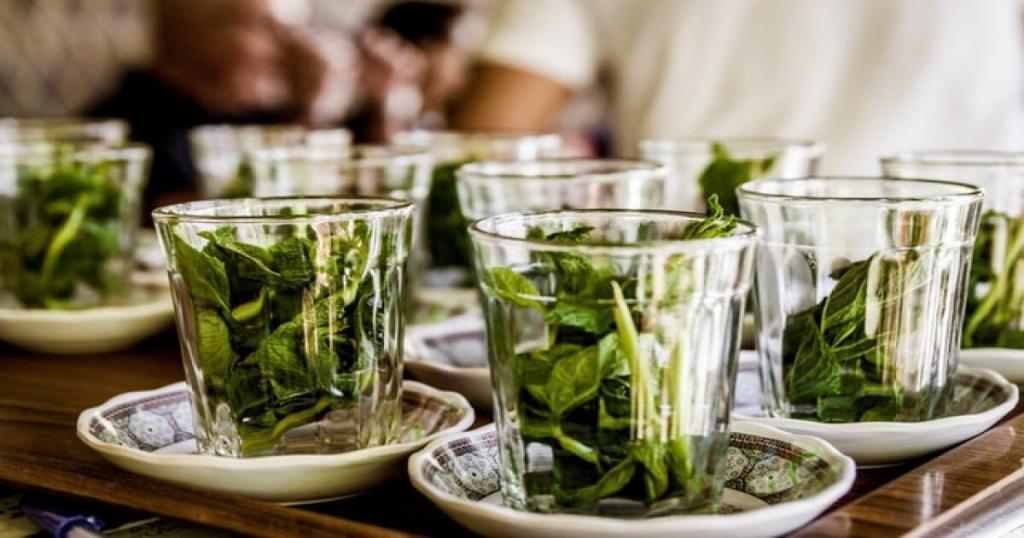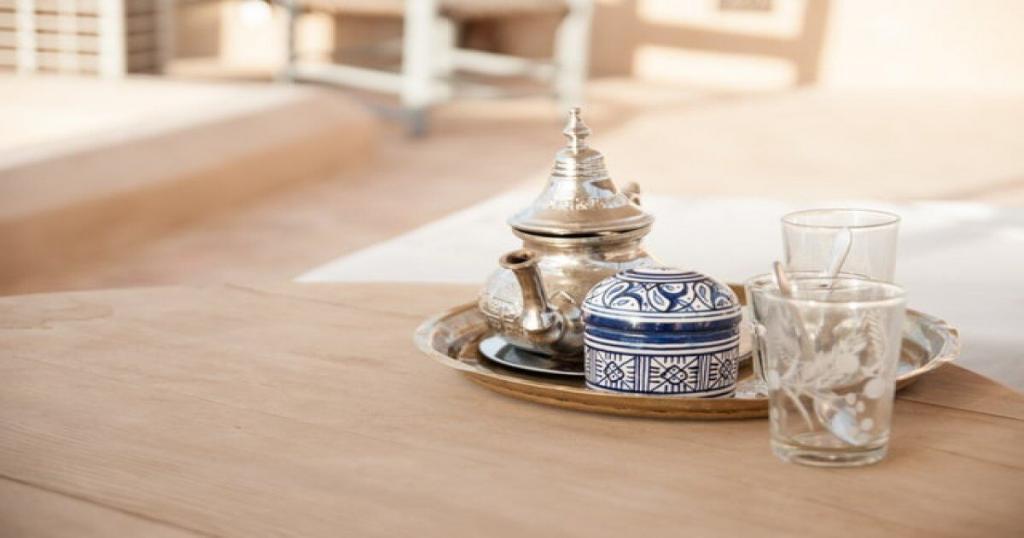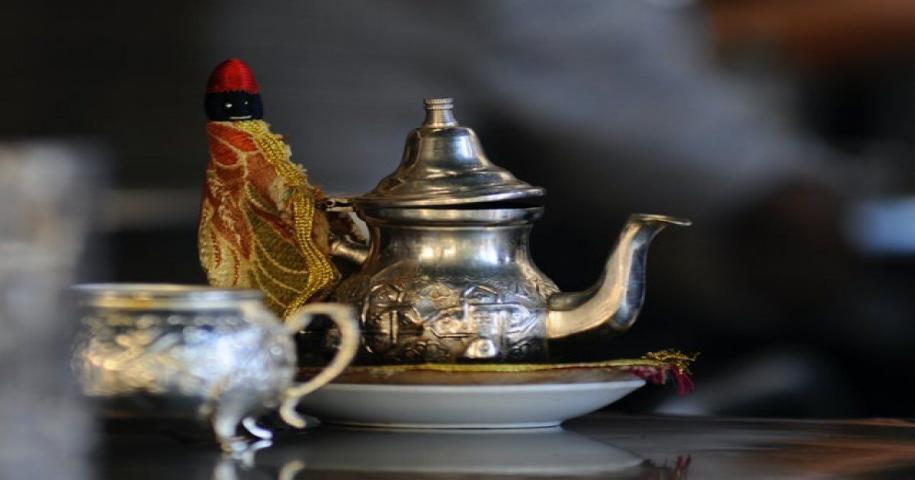Moroccan tea (the Berber Whiskey)
You cannot call yourself a true tea drinker if you have never tried a properly prepared Moroccan tea. It is not a particular variety or a general category of species that belong to a particular geographic area. It is a whole culture that contains both ingredients, various additives, proper serving, and the tradition of brewing. Therefore, it brings together not only the recipe but also the methodology.
But in addition to all this external background, this tea is also characterized by an easily recognizable taste, a pleasant hue, invigorating and tonic effect. In the hot season in the kingdom of Morocco, we have to escape from the scorching rays of the sun, to languish from the unbearable stuffiness. And as we know, in this case, hot tea effectively quenches thirst.
If you are willing to visit Morocco to try Moroccan tea, you are in the right place. Touring In Morocco is a specialist in organizing affordable Morocco tours, contact us now!
Moroccan tea – composition, and description
It is popular not only in the kingdom but also in the neighboring North African states. And besides, it is relevant in almost every city in Morocco itself. Accordingly, each region has its own indigenous traditions, which change the recipe, albeit slightly. And everyone is sure that their method is the only correct one.
In fact, if you dig a little deeper, the roots of history are very deep. There are several legends about how tea was imported or otherwise appeared in the Moroccan kingdom. One is the legend of a British merchant who, in the 18th century, lost his way in the war and found himself stranded on the sand dunes. According to another version, the British Queen personally sent the recipe to the Sultan of Morocco.

There is no historical confirmation of this, but it is known that long before that time, this kind of drink was practiced in the local environment. Muslims were forbidden to drink alcohol due to religious restrictions. So they found a rather logical alternative. It is worth saying that the basis for it was imported tea from distant China. And given the way of life of Berbers, who wandered from place to place. The green variety became the best way to quench thirst in the harsh heat. And it spread to all categories of the population, everyone from the poor man to the sultan paid tribute to it.
As a result, there were a great many recipes. But the three most important key figures remained unchanged. And whichever version you like, these three ingredients will always be present.
The Moroccan tea’s basic ingredients
- The Basics. Of course, if we’re talking about the classics, it can only be green tea. However, a black base is now allowed as well.
- Mint. And a specific Moroccan variety, not any that can be found on the supermarket shelves.
- Sugar.
In addition to these three pillars, there are a lot of different additional ingredients that can be included in the recipe. These include various spices, molasses, citrus zest, and slices, sometimes even milk. Although, given the fact that imports from China, unlike their Indian counterparts, had no bitterness, there was no need to quench it with milk.
Traditional Moroccan tea and peculiarities of the tea ceremony
As already mentioned, tradition is the basis in this case. The ceremony is of fundamental importance. For the locals, consumption is not simply a process of quenching thirst. It is practically a sacred sacrament, which is worth observing and honoring.
A striking example of the truth of this judgment is the attitude of Moroccans to guests. They will always be offered this particular drink if they see it on their doorstep. And if the guest refuses to share tea with the owner of the house, it can be perceived as a direct insult.
So, the traditional ceremony always uses a tall teapot with a long spout. And always made of metal. No porcelain or clay. No low crockery, as usual in Asian countries.
The different steps
It is brewed in a kettle, in two stages. The first is cleansing, simply rinsing the leaves, softening and leveling the bitterness, if any. To understand how to make Moroccan tea, it is important to grasp the fact that Moroccans only work with boiling water. Although, they usually use hot water up to 70-80° in ceremonies. But not in this case. Both the first brew and the second brew are only in boiling water that has just been taken off the fire.
After obtaining the brew, it is the turn of additional components. Mint, melissa, or citrus should be added. Finally, the resulting mixture should be poured again with water, but no longer with boiling water, but cool.
Next, we need to boil the brew again. For this, we need a metal kettle. Copper is suitable, it has excellent heat transfer properties, and it quickly heats up and cools down. We put the pot on the open fire, boil it and let it steep for a couple of minutes. It is noteworthy that after this procedure it is still impossible to pour the infusion. It is necessary to pour it into a glass, let it cool down, and put it back into the kettle. And repeat this maneuver a couple of times. Only after this, the temperature becomes optimal for serving.
And the key point – pouring. The main point, is the question of how to make Moroccan tea. Pouring needs to be from a person’s height. And it is worth saying that an untrained person is unlikely to cope with this task without spilling a drop. It would be logical to practice a little in advance. And this is the moment when you will appreciate the beauty of tall glasses.
How to make Moroccan tea at home
Of course, to recreate all the conditions that accompanied the ceremony in ancient Morocco in modern reality is problematic. But the locals have created their own ways.
By the way, to begin with, it is worth doing some of the preparations. Just buy a package of the product and draw water from the tap – will not work. More precisely, the result will be far from the expected.

Cooking conditions
The step-by-step recipe is not too complicated. First of all, we need to prepare water. And you need drinking water, purified, preferably from an underground source. The main thing is that the water should reach a temperature of 100° at the time of cooking. Do not let it cool under any circumstances.
The second point is the base. If we talk about the original, you need a green leaf tea from China exclusively Zhejiang. “Green Gunpowder” looks great in this role. Although, if you can not buy it, you can use a different basis. Now it is even possible to use black varieties.
Remember about the sugar. Even if you prefer a tart taste without sweeteners, it is strongly not recommended to exclude sugar. It violates the whole flavor balance, which is a distinctive feature. Cane sugar is necessary, preferably in cubes. This way a gradual dissolving and taste action is achieved.
Mint is naturally the main ingredient. We need a variety – spicata. Literally translated as “spiky”. One of the species of the genus. Easy enough to find in today’s store assortment.
The utensils used are a tall teapot with a narrow and long spout so that you can perform the famous pouring trick. As well as tall glasses. Glass, clear glasses are ideal.
To serve, take a massive tray and add a spread of sweets or honeycomb nearby. A sprig of fresh mint as a decoration.
Classic recipe
In fact, in most cases, it is used. And in North African countries, it is often the preferred type.
Ingredients
Everything is at the very minimum. It is required to prepare green tea, the amount of which depends on preference. A container of several liters. Clean drinking water, as well as in the neighborhood of five pieces of cane sugar. And of course, spiked mint to taste.
Cooking
- In the prepared jug, where we have already placed our tea leaves, we pour boiling water. And let it steep for a while, the leaves will open up, and with them the flavor.
- We drain the water, which will take away the bitterness and foreign flavors.
- Pour the hot water again, add sugar, no more than half, and bring to a boil on the fire.
- Pour it into glasses, and then put the tea back into the jug. And repeat this procedure three times before consumption.
With cinnamon
Not exactly a classic, but because of the cinnamon craze in the modern world, this method just couldn’t help but appear.
Ingredients
You only need a liter of water for a small portion. And for this volume, 3-4 spoonfuls of tea will be fine. Of course, it is better to use green tea from China. A little sugar, 30 or 35 grams. And most importantly, a cinnamon stick.
Preparing
- Pour the leaves with steeped boiling water in the usual way.
- Add mint. Then we put it on fire again. But not just to boil, but to really boil. We will have to keep it on fire for at least ten minutes.
- In the final stage, almost before removing from the fire, we add sugar and cinnamon.
- After pouring in a glass, you can also add a cinnamon stick. But in this case, the flavor will be very pronounced. And it will definitely overpower the traditional aromatic notes.
With spices
For those who like unusually bright and fruity motifs and want to try Moroccan-style tea, the recipe would be perfect.
The ingredients
The green tea leaf variety from Zhejiang province, which goes into all recipes. But as has been noted more than once, if you can’t get it, you can substitute it. We will also need half a liter of boiling water, a few cubes of refined tea, and mint. Here we finish with the standard and move on to the innovations. Among them, we should mention anise, cinnamon, and lemon.
Preparation
- We carry out the usual procedure with double brewing, which has already been described.
- We boil the drink with the main spices.
- A minute before removing, add cinnamon and anise.
- Before serving, it is worth spreading the lemon into glasses. You can do this even at the stage of pouring from the pitcher into the glasses, then the infusion will be more saturated with sourness.
With badjan
Ingredients
All that belongs to the original, green leaves, mint, and sweetener. We only add the badanian itself. Just a couple of stars are enough.
Preparing
There are practically no differences. Only the boiling process should be slightly longer compared to the classic. Three or four minutes after boiling. And it is at this point that we add our badian stars, which will play their part in the flavor.
With orange
Not only citrus lemon can be present in the preparation. Moroccan peppermint tea, the recipe for which we are now describing, is based on another representative, the orange. Accordingly, it is completely devoid of sourness and becomes more fruity and slightly sweeter.
The ingredients
Everything is the same as in the usual recipe. The only thing you need to add is an orange. A whole orange, not a couple of slices.
Preparation
Let’s skip the standard beginning. The orange is added already at the stage of being brought to the boil again. There is almost no need to boil, remove from the heat as soon as the temperature reaches 100°. But at the first stage, only half of the orange along with the peel is added. The second is peeled, divided into slices. And a different slice is sent to each glass of drink when pouring.
How to store
In its finished form, this product stores quite easily and for a long time. It can be sent to the refrigerator, of course, after it has cooled. It will be a great refreshing drink, which depending on the recipe may have a fruity or other flavor. But it ceases to be specifically Moroccan delicacy as soon as it cools down.
Benefits and harms
Considering what is Moroccan tea and the ingredients in its composition, it can have a tangible effect on the human body. This means that it can have both positive and negative effects.
Like any green drink of this kind, it contains tannin. Accordingly, it has an invigorating effect, relieves fatigue, tones the body, and improves mood. And the combination with peppermint allows you to relieve the strain of both physical and emotional plan, accumulated during the day.
Peppermint has an effect on the nervous system, so it is widely used in disorders of sleep, irritability, stress, and after hard work. It also contains antioxidants that have a positive effect on the perception of information. They help it be better assimilated and processed. In other words, it’s a great option while studying or preparing for exams.
The history of Moroccan tea says that Berbers used to consume it after meals all the time. And this is no coincidence. After all, it stimulates the secretion of gastric juice and helps proper and timely digestion. In general, it has a positive effect on the gastrointestinal tract, if there are no pathologies with contraindications.
By the way, the menthol content is always a huge plus, if colds loom on the horizon. Cough, sore throat – all this is soothed and suppressed (not cured) by menthol. In this case, it is recommended to increase the amount of mint relative to the standard when cooking.
Contraindications
They follow logically from the advantages. In the first place is menthol. We can immediately conclude that people with gastrointestinal disorders should avoid it. Especially if we are talking about gastritis or even the formation of ulcers. In addition, menthol is undesirable for asthmatics, as in fact for them it is an allergen. It is unlikely to provoke an attack, especially in such a weak concentration, but it is still better to reassure yourself beforehand.
For reasons of menthol and tannin, it is worth using with caution during pregnancy. And it is better to abstain. And of course, children under the age of four will be contraindicated.
As for the rest, if there are no pathological disorders, nothing will prevent you to discover a new milestone of tea pleasures, to getting acquainted with the predilections of the inhabitants of North Africa. And they, as practice shows, were real gourmands. To understand this, it is enough to look at the Moroccan tea, photos of which abound with a mass of additional fruit, berry, and honey components.


Leave a Reply